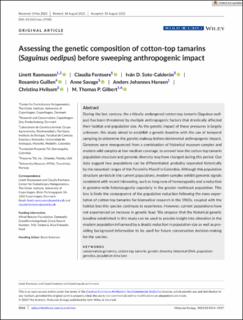| dc.contributor.author | Rasmussen, Linett | |
| dc.contributor.author | Fontsere, Claudia | |
| dc.contributor.author | Soto-Calderón, Iván D. | |
| dc.contributor.author | Guillen, Rosamira | |
| dc.contributor.author | Savage, Anne | |
| dc.contributor.author | Hansen, Anders Johannes | |
| dc.contributor.author | Hvilsom, Christina | |
| dc.contributor.author | Gilbert, Marcus Thomas Pius | |
| dc.date.accessioned | 2023-11-21T09:21:52Z | |
| dc.date.available | 2023-11-21T09:21:52Z | |
| dc.date.created | 2023-09-27T13:46:03Z | |
| dc.date.issued | 2023 | |
| dc.identifier.citation | Molecular Ecology. 2023, 32 (20), 5514-5527. | en_US |
| dc.identifier.issn | 0962-1083 | |
| dc.identifier.uri | https://hdl.handle.net/11250/3103773 | |
| dc.description.abstract | During the last century, the critically endangered cotton-top tamarin (Saguinus oedipus) has been threatened by multiple anthropogenic factors that drastically affected their habitat and population size. As the genetic impact of these pressures is largely unknown, this study aimed to establish a genetic baseline with the use of temporal sampling to determine the genetic makeup before detrimental anthropogenic impact. Genomes were resequenced from a combination of historical museum samples and modern wild samples at low-medium coverage, to unravel how the cotton-top tamarin population structure and genomic diversity may have changed during this period. Our data suggest two populations can be differentiated, probably separated historically by the mountain ranges of the Paramillo Massif in Colombia. Although this population structure persists in the current populations, modern samples exhibit genomic signals consistent with recent inbreeding, such as long runs of homozygosity and a reduction in genome-wide heterozygosity especially in the greater northeast population. This loss is likely the consequence of the population reduction following the mass exportation of cotton-top tamarins for biomedical research in the 1960s, coupled with the habitat loss this species continues to experience. However, current populations have not experienced an increase in genetic load. We propose that the historical genetic baseline established in this study can be used to provide insight into alteration in the modern population influenced by a drastic reduction in population size as well as providing background information to be used for future conservation decision-making for the species. | en_US |
| dc.language.iso | eng | en_US |
| dc.publisher | John Wiley & Sons Ltd | en_US |
| dc.rights | Attribution-NonCommercial-NoDerivatives 4.0 Internasjonal | * |
| dc.rights.uri | http://creativecommons.org/licenses/by-nc-nd/4.0/deed.no | * |
| dc.title | Assessing the genetic composition of cotton-top tamarins (Saguinus oedipus) before sweeping anthropogenic impact | en_US |
| dc.title.alternative | Assessing the genetic composition of cotton-top tamarins (Saguinus oedipus) before sweeping anthropogenic impact | en_US |
| dc.type | Peer reviewed | en_US |
| dc.type | Journal article | en_US |
| dc.description.version | publishedVersion | en_US |
| dc.source.pagenumber | 5514-5527 | en_US |
| dc.source.volume | 32 | en_US |
| dc.source.journal | Molecular Ecology | en_US |
| dc.source.issue | 20 | en_US |
| dc.identifier.doi | 10.1111/mec.17130 | |
| dc.identifier.cristin | 2179456 | |
| cristin.ispublished | true | |
| cristin.fulltext | original | |
| cristin.qualitycode | 2 | |

